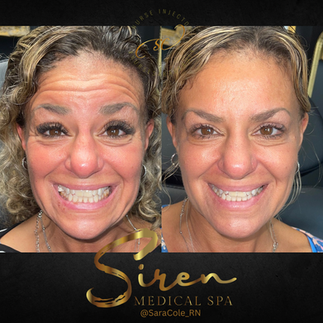Neurotoxins 101: What Are Botox and Dysport, and Which Is Right for You?
- Sara Cole
- Dec 4, 2024
- 3 min read
When it comes to non-surgical treatments for smoothing wrinkles and achieving a refreshed, youthful appearance, neurotoxins like Botox and Dysport are some of the most popular options available. But what exactly are these treatments, how do they work, and how do you choose the one that’s right for you?
Let’s break it all down and help you make an informed decision about these powerful wrinkle-relaxing treatments.
What Are Neurotoxins?
Neurotoxins, like Botox and Dysport, are purified forms of botulinum toxin type A, a naturally occurring protein that temporarily relaxes targeted muscles. By blocking nerve signals to these muscles, neurotoxins prevent them from contracting, which softens dynamic wrinkles caused by repeated facial movements.
Dynamic wrinkles include:
Crow’s feet around the eyes
Frown lines (also called “11s”) between the eyebrows
Forehead lines
When used correctly, neurotoxins don’t “freeze” your face but instead create a smoother, more refreshed look while still allowing for natural facial expressions.
Botox vs. Dysport: What’s the Difference?
While Botox and Dysport have the same active ingredient and work in a similar way, there are some subtle differences between the two.
Molecular Structure:
Dysport has smaller molecules, which allows it to spread more quickly and cover larger areas.
Botox has larger molecules, making it ideal for precise treatments in smaller areas.
Onset of Results:
Dysport tends to work slightly faster, with visible results often appearing within 2-3 days.
Botox typically takes 4-7 days to show results.
Dosage:
Dysport units are measured differently than Botox units, meaning a single treatment may require more units of Dysport than Botox. However, this doesn’t affect the cost as providers adjust pricing based on dosage.
Longevity:
Both Botox and Dysport last about 3-4 months, although some individuals find that one may last slightly longer than the other depending on their metabolism and treatment area.
How to Choose the Right Option for You
The decision between Botox and Dysport often comes down to your individual goals, facial anatomy, and the expertise of your provider. Here are a few factors to consider:
Treatment Area:
If you’re treating a larger area, like the forehead, Dysport’s ability to spread quickly might make it the better option.
For smaller, more precise areas like frown lines, Botox’s focused action is often preferred.
Desired Results:
If you’re looking for quicker results (e.g., before a special event), Dysport might be a better choice due to its faster onset.
For those who prefer gradual changes, Botox may be a good fit.
Personal Experience:
Some patients respond better to one product over the other due to differences in their body’s metabolism or preferences regarding the feel of the treatment.
Provider Expertise:
An experienced provider will assess your facial structure and recommend the product they feel will best achieve your goals.
What to Expect During a Neurotoxin Treatment
The process for both Botox and Dysport treatments is quick, simple, and minimally invasive:
Consultation: Your provider will discuss your goals, assess your facial anatomy, and determine which neurotoxin is right for you.
Preparation: The treatment area will be cleansed, and markings may be made to guide precise injections.
Injection: Using a fine needle, your provider will administer the neurotoxin into targeted muscles. Most sessions take about 10-20 minutes.
Aftercare: You’ll be advised to avoid rubbing the area or engaging in strenuous activity for 24 hours.
There’s little to no downtime, and you can return to your regular activities immediately after treatment.
The Results: Smoother, Refreshed Skin
Both Botox and Dysport deliver noticeable yet natural-looking results. After your treatment, you’ll see smoother skin and a more relaxed appearance without looking “frozen” or overdone. The effects typically last 3-4 months, after which you can schedule a follow-up appointment to maintain your results.
Final Thoughts
Choosing between Botox and Dysport doesn’t have to be complicated. Both are highly effective treatments for reducing the appearance of dynamic wrinkles, and the best choice often comes down to your specific needs and preferences. With the help of an experienced provider, you can achieve a refreshed, youthful look that enhances your natural beauty.
Are you ready to experience the wrinkle-smoothing magic of neurotoxins? Schedule a consultation with us today, and let’s create a personalized treatment plan that’s perfect for you!










Comments